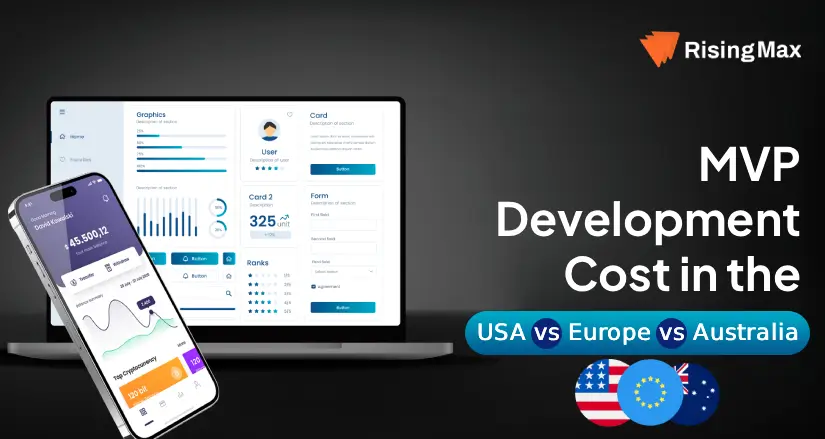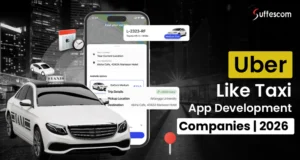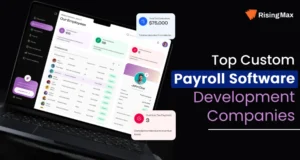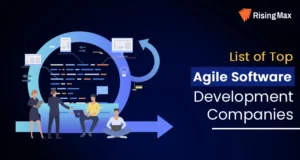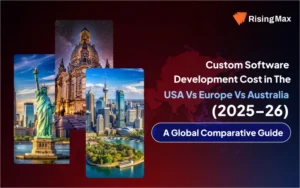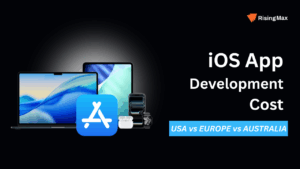Key Takeaways –
- MVPs let startups test their product in the market without overspending, with the typical MVP development cost in 2026 ranging from $7,000 to $45,000.
- MVP Development Costs Depend on Multiple Factors: Development cost varies by region, feature complexity, and team type (in-house, agency, or freelancers).
- Optimize Budget Strategically: Focus on core features, simple UI/UX, open-source tools, and agile sprints to reduce MVP costs by 40–60%.
Do you know running out of cash is the no. 1 reason for startups to fail?
That’s why most tech startup owners prefer an MVP version to test their idea among a real audience without exhausting their budget too much in the initial phases of their startup.
The cost to develop an MVP is significantly lower than a full-scale app. Typically, MVP development costs between USD 7,000 and USD 45,000. Furthermore, development costs depend on several factors, including app type, MVP app complexity, development timeframe, and the location of the developers.
In this comparison breakdown, we will analyze how the development cost of MVP varies as per region, app type, and what the hourly rates of MVP developers in the USA, Europe, and Australia are. We will also discuss some of the optimization strategies and use cases to help you relate your project and calculate the estimated budget for your app.
But first, let us understand what the purpose of developing an MVP is and what features it provides!
Feature & Purpose of an MVP
An MVP (Minimum Viable Product) is the most basic version of an app or software, which includes only core functionality and lacks user engagement elements such as animations, advanced features, etc.
Features of MVP
- Includes core functionality and must-have features only.
- Minimum design complexity so that users can adapt to the new app or software easily.
- Although it includes essential features, it is built with a scalable tech stack.
- Includes an active tracking mechanism to gather detailed user feedback.
Purpose of Building MVP
The basic version of the app/software is built to:
- Test if the product demand is there in the market.
- Check if the users liked the solution before investing too much into the development.
- Gather user feedback on usability, features, and expectations.
- Demonstrate their product and its feasibility to investors.
- Launch early and later adapt as per market requirements.
Sometimes, the launch of MVP is seen as providing an incomplete solution, while it is actually a smart move to test your idea and solution on real ground. Processing user feedback and modifying the app according to user preferences increases the chances of success of the startup.
In fact, many get confused between MVP and prototyping. Both serve different purposes and are entirely different from each other. Here’s a breakdown of the usability of both –
| Usability Aspect | MVP (Minimum Viable Product) | Prototype |
| Purpose / Goal | Validate real market demand, functionality, and viability with actual users | Test and validate design, user flows, usability, and user interface concepts |
| Functionality | Fully functional core features—works end-to-end for the primary use case | Low or no functional backend; often uses dummy data or static screens |
| Target Audience | Early adopters, real users, paying customers | Internal teams, stakeholders, designers, early testers |
| Technical Depth | Deeper—real business logic, data handling, integrations (within scope) | Shallow—mostly front-end visuals, transitions, click-throughs |
| Feedback Type | Quantitative + qualitative (data on usage, retention, conversion, etc.) | Qualitative (e.g. “Do users understand this flow or layout?”) |
| What It’s Not | Not a prototype dressed up—it must work for users | Not fully usable or sellable |
| When to Use | After validating the design, when you’re ready to test real user behavior and monetization | Early development stage, when you need to iterate UI/UX quickly & cheaply |
Stages of MVP App Development & Their Impact on Project Cost
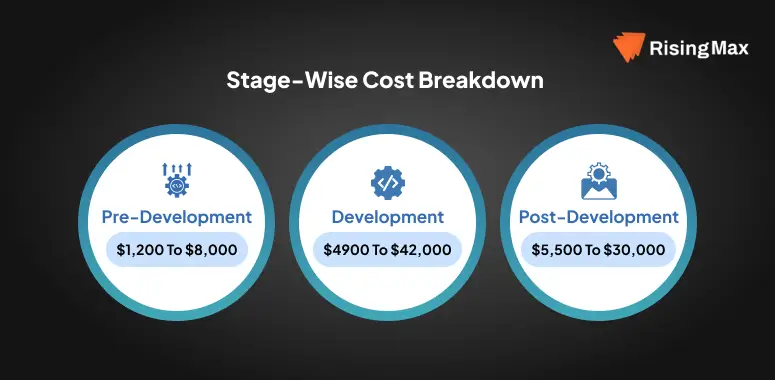
The complete process of building an MVP, or any app, can be divided into three stages:
- Pre-Development
- Development
- Post-Development
We often overlook the first and last stages when planning the budget. Let us understand how these stages impact the overall budget:
Pre-Development –
This stage includes crucial steps that will shape the tech stack, developers’ approach, and thus the development cost. This stage includes:
1. Market Analysis
You may require a few days to a few weeks to analyze the market. Having a deep understanding of the market gap helps you address the pain point with your product, thereby increasing the chances of its success. Depending on the depth of the research and analysis, the budget may vary!
2. Wireframing & Designing
Creating low-fidelity sketches and visual prototypes helps developers to imagine the app/software with clarity. These prototypes can reduce the tech debt that might come up in the later stages of development. Also, you get a chance to modify certain designs and layouts after analyzing the wireframe, which in later stages can be a tedious and costly task.
USA, Europe, Australia Pre-Development Cost Breakdown
| Stage | USA (USD) | Europe (USD) | Australia (USD) |
| Market Research & Competitor Analysis | $800 – $2,500 | $600 – $1,800 | $650 – $2,000 |
| Requirement Gathering & Documentation | $400 – $1,500 | $300 – $1,200 | $350 – $1,300 |
| Wireframing & User Journey Mapping | $200 – $1,200 | $150 – $900 | $180 – $1,000 |
| UI/UX Design (Basic Prototype) | $100 – $2,800 | $150 – $2,600 | $120 – $2,700 |
| Total (Pre-Development) | $1,500 – $8,000 | $1,200 – $6,500 | $1,300 – $7,000 |
*All prices are in USD.
Development
Once the ideation and conceptualization are done, the app/software then shifts to the development stage. However, this stage can be further divided into 4 core stages. The development cost may range from $4,900 to $42,000. Here’s an overview of the region-wise cost breakdown of the development stage of an app/software:
| Stage | USA (USD) | Europe (USD) | Australia (USD) |
| 1. UI/UX Design (Detailed Screens) | $1,500 – $7,000 | $1,000 – $5,000 | $1,200 – $5,500 |
| 2. Frontend Development (Web/App UI) | $2,000 – $12,000 | $1,500 – $9,000 | $1,800 – $10,000 |
| 3. Backend Development (Database + APIs) | $2,500 – $20,000 | $2,000 – $15,000 | $2,200 – $16,000 |
| 4. Deployment (App Store / Cloud Setup) | $500 – $3,000 | $400 – $2,200 | $450 – $2,500 |
| Total (Development Stage) | $6,500 – $42,000 | $4,900 – $31,200 | $5,650 – $34,000 |
Let’s discuss them one by one and examine how the cost factor will fluctuate among these stages.
UI/UX Design
The designers pick up the wireframes and low-fidelity sketches and turn them into high-fidelity (highly detailed) prototypes using Figma or Adobe XD. These samples give developers and founders a clear idea of how their app/software is going to look and feel.
The user interface is a major factor in determining user satisfaction and thus retention, which is why most founders and investors invest more in this stage.
UI/UX Designer Hourly Rates in the USA, Europe, and Australia:
| UI/UX Designers’ Average Hourly Rates | USA | Europe | Australia |
| $50 – $100 | $35 – $70 | $45 – $85 |
*All rates are in US$
Front-End Development
Now comes the developers’ role. The front-end developers convert the designed prototypes into an actual app by adding features and functionality to the app. Front-end developers are also responsible for integrating the back-end and APIs, and serving them to the users.
Here’s an estimation of the average front-end developers’ hourly rates in the USA, Europe, and Australia:
| Front-end developer Average Hourly Rates (Rates are in US$) | USA | Europe | Australia |
| $60 – $120 | $40 – $80 | $50 – $95 |
*Depending on the framework, hourly rates may vary for framework seniority.
Backend Development
This stage includes developing a server-side system. Developers focus on creating a database, storage bucket, user data management, and integrating third-party services such as payment gateways, social media APIs, geo-location services, etc.
Backend developers’ average hourly rate in the USA, Europe, and Australia varies as per:
| Back-end Developer Average Hourly Rates | USA | Europe | Australia |
| $70 – $130 | $45 – $90 | $55 – $105 |
*All rates are in US$
Deployment
Front-end and back-end development usually go hand-in-hand and complete the building process of the app/software. You can view and even run the full app on your local system, but to make it online, you need to deploy the app using hosting services.
Usually, the deployment cost is low and largely varies depending on the platforms being used for hosting and deployment.
Post-Development (Ongoing/Maintenance Cost)
Most startup founders often overlook the post-development cost; however, it may have a significant impact on the overall project cost. As the project is deployed, it goes into rigorous testing by the QA (Quality Assurance) testers.
QA testers conduct automated and manual testing to test,
- The scalability of the app and whether the app can handle unexpected traffic spikes.
- Whether the app contains all the features as requested in the PRD (Product Requirement Document).
After the QA testing, the product may also shift to beta testing. In this stage, you may receive valuable feedback regarding the app’s feasibility and also some bug reports.
Although post-development cost comes under ongoing or maintenance cost, here’s a generalized overview of how it may vary as per different factors,
| Factor | USA (USD) | Europe (USD) | Australia (USD) |
| Quality Assurance & Testing | $1,000 – $5,000 | $800 – $3,800 | $900 – $4,200 |
| Maintenance & Bug Fixes (Annual) | $2,000 – $8,000 | $1,500 – $6,000 | $1,700 – $6,500 |
| Feature Updates / Enhancements | $2,500 – $10,000 | $2,000 – $7,500 | $2,200 – $8,000 |
| Scaling & Performance Optimization | $1,500 – $7,000 | $1,200 – $5,500 | $1,300 – $6,000 |
| Total (Post-Development Stage) | $7,000 – $30,000 | $5,500 – $22,800 | $6,100 – $24,700 |
Factors That Make up The Development Cost of MVP (Region-Wise Cost Implication)
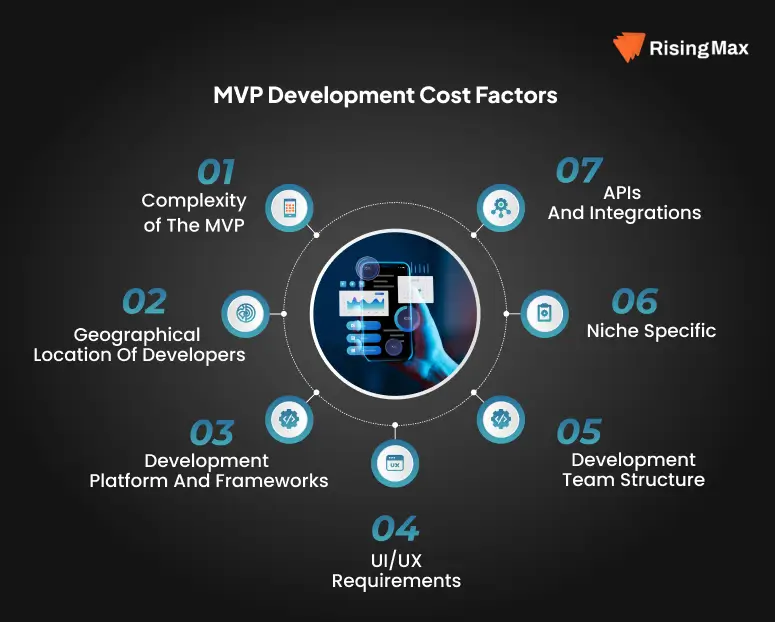
There are several factors at play when it comes to calculating the total cost of MVP. Most of these factors fall under the category of critical to very critical from the business point of view, thus can’t be ignored. Among all of these factors, which are also discussed below, the MVP app scope and complexity are the primary ones and account for at least 60% of the development cost.
Let’s shed some light on each of the factors and how influential they are in shaping the development cost of the MVP.
1. Complexity of the MVP
Although MVP is itself a basic version of any app, the complexity level may still vary depending on the industry and the solution that your app is aiming to provide. For example, a simple status website/app/software will be much simpler than a simple app, but it will have a payment gateway integration.
Generally speaking, here’s a rough idea about the features that increase the complexity level of the app and their impact on the cost of development of MVP:
| MVP Type | Features | USA (USD) | Europe (USD) | Australia (USD) | Remarks |
| Basic MVP | Core features only (auth, simple CRUD, reports) | $7,000 – $15,000 | $5,500 – $12,000 | $6,000 – $13,000 | Best for solo founders & small startups testing an idea |
| Moderate MVP | Everything in Basic + dashboards, push notifications, role-based users | $15,000 – $30,000 | $12,000 – $25,000 | $13,000 – $27,000 | Suitable for MSMEs, SaaS pilots, growing teams |
| Advanced MVP | Industry-specific MVPs (fintech, health, retail) + integrations (payment, APIs, analytics) | $30,000 – $45,000 | $22,000 – $38,000 | $25,000 – $40,000 | Still MVP-level but with more complex modules, often targeting investors |
2. Geographical Location of Developers
Another major factor is the location of developers. Hiring developers from the USA will cost more than hiring from Australia or Europe. Among these three regions, the developer’s hourly rate varies as follows:
Highest in the USA > Australia > Europe
Take a look at how development hourly rates and overall cost vary in the USA, Europe, and Australia:
| Region | Avg Hourly Rate (USD) | Typical MVP Cost Range (USD) | Cost Impact | Remarks |
| USA | $80 – $120/hr | $7,000 – $45,000 | Highest | Premium pricing, top-tier expertise, strong startup ecosystem |
| Europe (Eastern & Western) | $50 – $90/hr | $5,500 – $38,000 | Moderate | Cost-efficient, diverse talent, good balance of quality & affordability |
| Australia | $60 – $100/hr | $6,000 – $40,000 | Medium-High | Slightly cheaper than US, strong quality standards, timezone advantage for APAC |
3. Development Platform and Frameworks
Choosing the right developmental platform is equally essential in determining the success of the app. Depending on the requirements and app features, you may need to choose among native, near-native, and web platforms.
Additionally, using advanced frameworks such as Node.js, Angular, etc may increase additional cost.
4. UI/UX requirements
Increasing detailing in the user interface and adding even slight transitions might increase the development hours, thus the cost. Also, increasing the functionality and features of the app adds to the complexity and increases the project cost.
| Design Complexity | USA (USD) | Europe (USD) | Australia (USD) |
|---|---|---|---|
| Basic UI/UX (ready-made templates, minimal branding) | $2,000 – $5,000 | $1,500 – $4,000 | $1,800 – $4,500 |
| Moderate UI/UX (custom layouts, responsive design, mobile + web) | $5,000 – $10,000 | $4,000 – $8,000 | $4,500 – $9,000 |
| Advanced UI/UX (micro-interactions, animations, complex flows, RTL/Localization) | $10,000 – $15,000 | $7,500 – $12,000 | $8,000 – $13,000 |
5. Development team structure.
Next comes the team structure. For your MVP development, you have three options:
- Build your own development team.
- Partner with a reliable app development company.
- Hire freelancers.
Each approach has its own pros and cons.
| Team Setup | Cost Impact (USD) | Pros | Cons | Best For |
| In-House Team | High ($100K+/year for salaries & overheads) | Full control, direct communication, cultural alignment | Expensive, long hiring process, limited flexibility | Enterprises, funded startups with long-term roadmap |
| App Development Company (Agency) | Medium–High (MVP: $7K – $45K) | Expert team ready, faster delivery, proven processes, expert solutions, dedicated project manager for coordination | Less direct control | Startups & SMEs seeking balance of speed + quality |
| Freelancers | Low–Medium (Flexible, hourly/daily rates) | Budget-friendly, scalable per need, global talent access | Quality varies, risk of delays, harder to manage | Early MVPs, solo founders, limited budgets |
6. Niche specific
Depending on the niche of your app, you may need to take regulatory compliance into account. For example, a healthcare app/software will have to achieve compliance with HIPAA, GDPR, FHIR, etc. Depending on the country, these regulations may have varying impacts on the cost of MVP development.
| Industry | Key Compliance Needs | Cost Impact | Remarks |
| Healthcare | HIPAA (USA), GDPR (EU), HL7/FHIR standards | High – requires secure data storage, encryption, audit trails | Non-compliance risks fines; must handle patient data safely |
| Finance / FinTech | PCI DSS, KYC/AML, SOC 2 | High – extra layers for secure transactions & fraud detection | Essential for apps with payments, banking, wallets |
| E-Commerce / Retail | GDPR (EU), CCPA (California), PCI DSS (payments) | Medium – data privacy + secure checkout | Impacts payment integration & customer trust |
| EdTech | COPPA (children), GDPR | Medium – parental controls, consent, secure cloud storage | Required when targeting students/minors |
| Enterprise / SaaS | SOC 2, ISO 27001, GDPR | Medium–High – strict audit, access control, encryption | Needed for B2B SaaS adoption in regulated sectors |
7. APIs and Integrations
APIs (Application Programming Interface) and third-party integrations are great for providing future-ready features and enhancing the user experience. More APIs will naturally increase the overall project cost, as well as post-deployment charges.
Although many APIs provide free tier usage, only to a certain limit; afterwards, you may need to pay on a monthly/biannual/annual basis. Therefore, it is recommended to closely monitor the usage of integrated APIs.
Region-wise Cost Breakdown of MVP Development in the USA, Europe, Australia
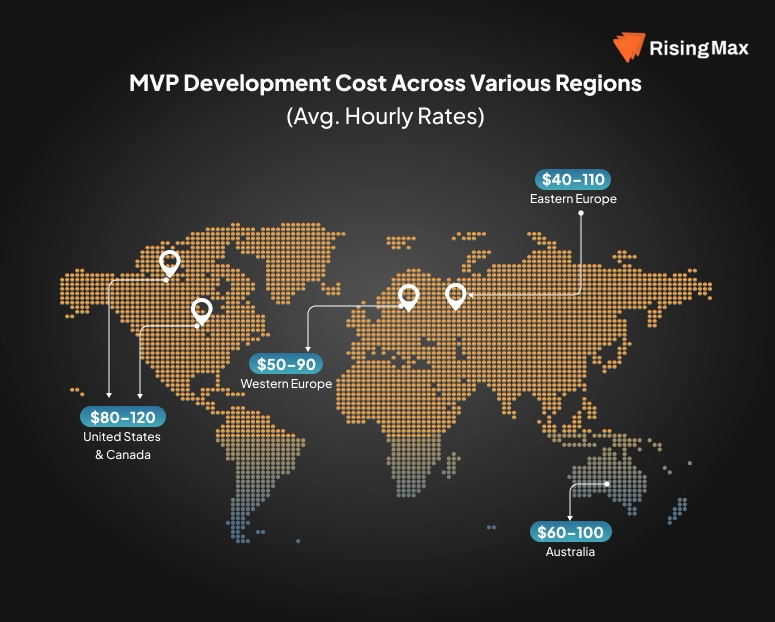
Now that you have an idea about the development stages, factors, and their impact on cost, let us take a closer look at how the rates vary across different regions. Having a clear picture of the cost variation helps you to select the region for the development.
| Region | Avg Hourly Rate (USD) | MVP Development Cost (USD) | Remarks |
| USA | $80 – $120/hr | $7,000 – $45,000 | Premium talent, fastest delivery, top-tier expertise |
| Europe | $50 – $90/hr | $5,500 – $38,000 | Cost-effective, high-quality dev hubs (Poland, Romania, Germany) |
| Australia | $60 – $100/hr | $6,000 – $40,000 | Slightly cheaper than US, strong standards, APAC timezone advantage |
Although the USA has the highest development cost, the country provides top-tier solutions and has an accelerating startup ecosystem.
Cost Breakdown in America
An American developer can charge anywhere between $70 and $200; however, when moving towards Latin America, average hourly rates typically decrease. North America has the most supportive tech environment, especially for startups.
Here’s a breakdown of MVP development cost in America:
| Region | Country | Avg Rate (USD) / Hour | Approx. MVP Cost (USD) |
| North America | USA | $70 – $200 | $7,000 – $45,000+ |
| Canada | $50 – $180 | $7,500 – $40,000 | |
| South America | Mexico | $30 – $60 | $5,500 – $20,000 |
| Brazil | $40 – $80 | $6,500 – $22,000 | |
| Argentina | $50 – $70 | $7,000 – $23,000 | |
| Colombia | $35 – $60 | $6,000 – $18,000 | |
| Chile | $40 – $70 | $6,500 – $20,000 |
Cost Breakdown in Europe
Among the three regions discussed here, Europe is one of the most affordable regions for MVP development. Cost varies significantly among various countries, for example, countries like the UK or Switzerland have higher rates than Eastern European countries such as Ukraine or Romania.
Here’s a complete overview of MVP developmental prices in Europe:
| Sub-Region | Country / Region | Avg Rate (USD) / Hour | Approx. MVP Cost (USD) |
| Western Europe | UK | $60 – $150 | $10,000 – $40,000 |
| Germany | $55 – $120 | $9,000 – $35,000 | |
| France | $50 – $110 | $8,500 – $32,000 | |
| Netherlands | $55 – $115 | $9,000 – $34,000 | |
| Southern Europe | Spain | $40 – $95 | $7,000 – $28,000 |
| Italy | $40 – $100 | $7,500 – $29,000 | |
| Eastern Europe | Poland | $30 – $65 | $6,500 – $22,000 |
| Ukraine | $25 – $55 | $6,000 – $18,000 | |
| Romania | $30 – $60 | $6,000 – $19,000 | |
| Hungary | $35 – $65 | $6,500 – $21,000 | |
| Northern Europe | Sweden | $55 – $120 | $9,000 – $35,000 |
| Norway | $60 – $130 | $10,000 – $36,000 | |
| Central Europe | Switzerland | $70 – $150 | $12,000 – $40,000+ |
| Austria | $50 – $110 | $8,500 – $30,000 | |
| Czech Republic | $35 – $70 | $6,500 – $22,000 |
Cost Breakdown in Australia
Australia is a prominent tech hub in the region. Due to its competitive market and high living standards, Australia has higher charges than Europe but offers more affordable development solutions than the USA.
Hiring an MVP developer in Australia might cost you between $45 and $120, depending on the project requirement and app complexity.
Typically, the range varies as below:
| State | Sub-Region / Area | Avg Rate (USD) / Hour | Approx. MVP Cost (USD) |
| New South Wales | East Coast | $50 – $120 | $9,000 – $38,000 |
| Victoria | South-East | $45 – $110 | $8,500 – $35,000 |
| Queensland | North-East | $40 – $100 | $7,500 – $32,000 |
| Western Australia | West Coast | $45 – $110 | $8,000 – $34,000 |
How Can You Calculate the Most Accurate MVP Development Cost Estimation?
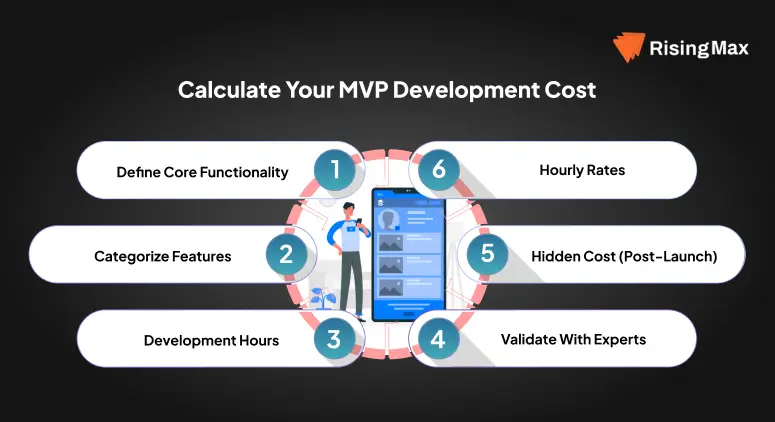
Before hiring the developers for your MVP app development, it is important to have an estimate of the cost structure so that you can negotiate well with the developers or with the agency. Moreover, by having a clear cost estimation of MVP app development, you can plan your budget as well as the project efficiently.
Here’s a step-by-step process to calculate the cost estimation of MVP app development:
1. Define the Core Functionality of the App
The very first thing to do is to understand your app completely from front to back.
List all the core and must-have features of your app. Note that an MVP version contains only the essential features; anything that comes under the nice-to-have category, try to ignore it.
Also include the target platforms for which you are developing your app. Platforms decide which tech stack to use for development. For example, if you are developing an app for the iOS platform, then you may need to build it using Swift. Similarly, for Android, you need to use Kotlin, or you may use React Native for a cross-platform build.
2. Define Each Feature and Label As Per Their Complexity
The next step is to define the feature set and categorize them according to their complexity. You may need to consult with a project manager or a developer to get an accurate idea about the level of difficulty and their estimated cost impact.
You may also divide the feature set into defined tasks. Such categorization also helps to define sprints in the agile development methodology.
Here’s a general idea about the features and their level of complexity:
| Example Feature | Task Complexity | Estimated Hours |
| User Login | Medium | 12 |
| Dashboard | Complex | 40 |
| Push Notifications | Medium | 15 |
3. Estimate Development Hours
Developmental hours have a direct impact on the overall budget. Based on the tasks that we defined in the previous step, assign developmental hours to each one of them. Keep in mind to include various aspects of the development, including the UI/UX design and QA testing.
Once you have a clear idea of the total hours, you can use the formula to estimate the overall cost of the project.
Formula for MVP Development Cost = (Total Developmental Hours) x (Average Hourly Rate)
Also, it is recommended to add a 10-20% buffer for miscellaneous expenses.
4. Decide Hourly Developmental Rates
Based on the region and expertise of the developers, decide on average hourly developmental rates. You may also take reference from the above tables to have a clearer idea. Hourly rates also vary depending on the nature of the team. Hiring freelancers will be cost-effective than building an in-house developers’ team.
5. Keep Space for Hidden Cost
While planning the MVP development budget, you should also consider taking notes about some non-developmental expenses. These may include pre-development stages, such as market research and project planning, or post-development stages, such as hosting and billing for cloud services.
6. Validate Your MVP Estimation with Practical Examples
The next step is to validate your estimation and projections with the real-world examples. You may look for research papers across the internet or refer to the latter section in this blog to get an estimate of the cost estimations of MVP across different industries!
7. Get Professional Consultation
By following the above-mentioned steps, you might get a close and accurate cost estimation; however, the prices may still fluctuate. Therefore, it is best to consult with a professional MVP app development company. They can provide you with the exact pricing structure as well as an estimated timeline and time-to-market for your app.
Several companies, including RisingMax, also provide additional services to help clients with ideation, market research, and setting up core modules for MVP. Thus ensuring that each step of the process goes smoothly.
How To Optimize Your MVP Development Budget Effectively & Strategically
Now that you have a clear idea about the market rates and average hourly rates of different regions, let’s optimize the budget. These strategies will focus on keeping the features and MVP app scope steady while cutting the development cost.
The 20:80 Pareto Principle
Focus on building those 20% features that deliver 80% of the value. This is by far the most effective method to optimize your budget. A smaller number of features means reduced budget, and by including only core modules, you ensure that your MVP can still provide enough insights to users about its capabilities.
Keep UI/UX Subtle
UI/UX enhancements can increase the development cost by two or threefold. For MVP, maintain a simplistic design with minimal animation. This step will directly impact two developmental stages:
- UI/UX Design
- Less Frontend Code
Therefore, you can save a significant amount with this approach.
Use Open Source APIs & Platforms
There are several APIs and even hosting and backend platforms that provide a free-tier or at least a low-cost solution. For example, you can choose a web-based application in the initial phases, depending on the functionality. Also, frameworks like React Native for development and platforms like Firebase for backend and hosting offer a free tier solution upto certain usage limits.
Opt for Sprint-Based Agile Development
Instead of completing the whole project at once, consider dividing it into milestones, also called sprints. These sprints allow the team to work simultaneously on various aspects and ensure better resource allocation.
Low-Code or No-Code Solutions
With the rise of generative AI, several platforms have emerged that offer simple drag-and-drop app development techniques. Such methodologies usually have less cost than a traditional full-code solution.
Recurring Testing After Each Developmental Stage
We all have heard the famous proverb, “Prevention is better than cure.”\
The same applies to app development. Test your product after each stage of the development. Early detection of bugs and iteration to feedback brings reduced cost fluctuation than applying changes post-development. Therefore, be it prototype designing or frontend coding, conduct recurring testing alongside.
Agree on Fixed Pricing
If you are hiring an offshore development team, instead of hiring on a monthly basis, opt for a contract. The lump sum amount may feel heavy, but overall, it is an effective method for better price negotiations. You can further divide the contract into milestone-based payment delivery.
By following these simple yet effective tips, you can reduce the MVP development cost by 40-60%.
Real World MVP Case Study
Remember, we talked about validating your MVP with practical estimations? Here are a few real-world examples discussed:
Uber
Take a look at Uber’s MVP Design & Layout back in 2010:
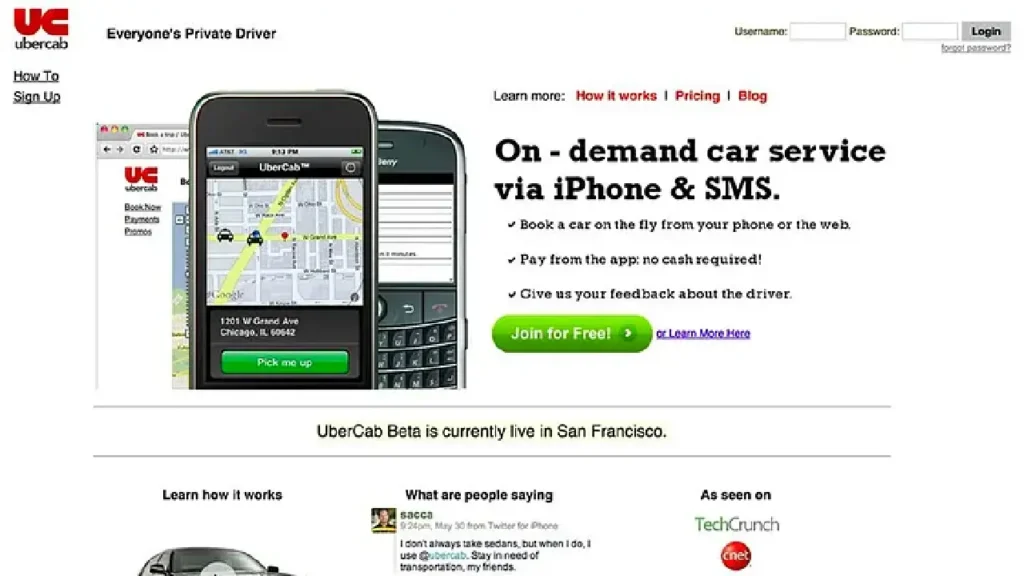
*Image taken for educational purposes.
When Uber was testing out its idea, it focused on minimal design, showing upfront what users can get. Even to test out its beta version, through which you could access features such as online booking, you had to email one of their founders.
Over time, they gathered market data, iterated accordingly, and now it is one of the big giants of its industry.
Airbnb
If you are a traveller, you must have used Airbnb on multiple occasions. You’ll be surprised to see the interface it had in the beginning. Have a look at it –
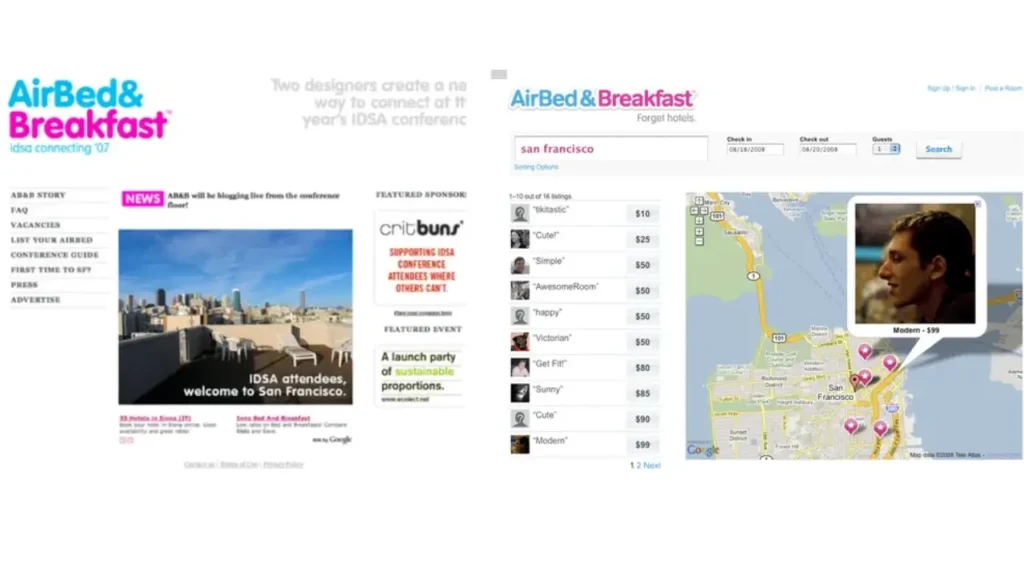
*Image taken for educational purposes.
They too identified the core problem (difficulty in booking accommodation in San Fransico back then) and to test their idea, the founders focused on providing that 20% features that can provide 80% of the value.
They even posted their own house available for the weekend to test their idea. And guess what? That weekend, they got 3 guests. This was enough validation for the founders to proceed with the idea.
Even in today’s times, Airbnb focuses on adding more listicles, attracting more customers with a subtle focus on aspects like design and interface. This approach stays valid for apps of any niche. Always provide a friendly interface and easy navigation for better user retention, and set up a friendly environment for new users.
You can develop an app with such a simplistic design and integrate only essential features for around $7000 to $20,000.
Wrap Up
Opting for MVP is one of the best ways to test your idea in the market without exhausting too much of your budget. While calculating the cost of MVP app development, it is important that you count hidden factors of pre- and post-development stages to avoid unexpected cost surges during the development process.
MVP development costs in the USA, Europe, and Australia range between USD 7,000 and USD 45,000. The cost largely depends on the app scope, niche, and feature set.
Risingmax provides best-in-class MVP app development solutions. We are a professional IT consulting company based in NYC. With 11+ years of experience, we have expertise in delivering above-the-mark solutions for Android, iOS, and cross-platform app development solutions.
Got an idea to discuss and validate? Let’s develop an MVP solution for your idea!
FAQs
Q1. What is the average cost of MVP development in the USA, Europe, and Australia?
Ans. The average cost of MVP development in the USA, Europe, and Australia is –
- USA – $7,000 to $45,000
- Europe – $5,500 to $38,000
- Australia – $6,000 to $40,000
The MVP development cost mainly varies depending on the app’s complexity, niche, development team size, deployment platforms, and tech stack.
Q2. Why does MVP development cost vary by region?
Ans. MVP development costs vary by region due to differences in developer hourly rates, local living standards, and market demand. Higher rates in some regions increase development costs, while regions with lower rates can offer more cost-efficient solutions.
Q3. How long does MVP development typically take?
Ans. MVP development typically takes between three to six months. The timeline depends on the complexity of the features, the technology stack used, and the development methodology.
Q4. Which features are most expensive to develop in an MVP?
Ans. The most expensive features to develop in an MVP are typically complex backend integrations, such as payment gateways or APIs, interactive dashboards, and advanced UI/UX designs.
Q5. What technology stacks are most cost-effective for MVPs?
Ans. The most cost-effective technology stacks for MVP development include open-source frameworks such as React Native, Flutter, Node.js, and Firebase. These frameworks allow for rapid development, lower costs, and easier scalability.
Q6. How can I reduce the cost of my MVP without sacrificing quality?
Ans. You can reduce MVP development costs by prioritizing core features that deliver the most value, using open-source APIs and tools, keeping the UI/UX simple, adopting agile development sprints, and outsourcing strategically to cost-effective regions.
Q7. What hidden costs should I prepare for beyond development?
Ans. You should also prepare for hidden costs beyond development, including market research, project documentation, hosting and cloud services, quality assurance testing, maintenance, and compliance with relevant regulations.
Q8. Is outsourcing MVP development to Eastern Europe or Australia a good idea?
Ans. Choosing the right region depends on your project requirements and budget. Outsourcing MVP development can be a good strategy. Eastern Europe offers cost efficiency and access to skilled developers, while Australia provides a balance of quality, reliability, and affordability.
Q9. How important is UX/UI design in the MVP cost?
Ans. UX/UI design is very important in MVP development because it can increase costs by two to three times. However, investing in good design is essential for user adoption, engagement, and long-term success of the product.
Q10. How do time zone differences affect MVP development costs?
Ans. Time zone differences can slow down communication and extend development timelines, which may indirectly increase costs. Collaborating with nearshore or offshore teams that have overlapping working hours can help minimize these delays.
Q11. What role do testing and QA play in MVP budgeting?
Ans. Testing and quality assurance play a critical role in MVP development. Proper QA helps prevent costly post-launch fixes and ensures a stable, reliable product. QA costs typically range from $900 to $5,000 or more, depending on the region and complexity of the app.
Q12. Can no-code platforms reduce MVP development costs?
Ans. Yes, no-code platforms can reduce development costs and time, especially for simple apps. However, they offer limited flexibility and may not be suitable for highly complex or scalable applications.
Q13. How does agile methodology impact MVP development expenses?
Ans. Agile methodology helps optimize resources, reduce rework, and improve budget predictability. By breaking development into sprints, teams can focus on high-priority features while keeping costs under control.
Q14. What are the risks of under-budgeting MVP development?
Ans. Under-budgeting an MVP can lead to delays, lower-quality features, incomplete functionality, and difficulties in scaling the product. This often results in higher costs in the long run due to rework and post-launch fixes.
Q15. How can RisingMax help optimize my MVP development costs?
RisingMax helps optimize MVP development costs by providing expert consultation, efficient project planning, and scalable technology solutions. Their end-to-end MVP development services ensure high-quality results at competitive rates, delivering better value for your investment.

